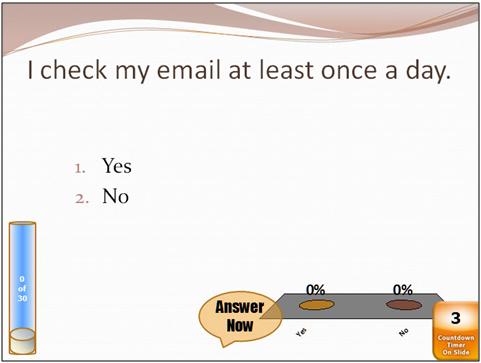by Eric Landrum [Note: I am thrilled that Sue Frantz has allowed a guest blog to appear here within her excellent Technology for Educators blog. I just hope I don’t ruin the neighborhood].
Recently heard at an anonymous meeting: “Hi, my name is Eric, and I am a clicker user.” [Audience in unison: “Hi Eric”]. OK, so I don’t think there are truly CA meetings, but I hope by the end of the this post you may be a bit more intrigued about why someone would use clickers in the classroom.
There are many different vendors and software systems for the use of audience response systems (AKA clickers)—summary to follow. And there are also web-based smartphone applications that do not require separate clicker hardware, just the use of text messaging or an app on your phone. But here I will highlight my use of Turning Technologies TurningPoint software, which is an add-in to Microsoft Word, in conjunction with the TurningPoint XR response device.
The general web site for Turning Technologies is here: http://www.turningtechnologies.com/
To download the free PowerPoint software add-in: http://www.turningtechnologies.com/responsesystemsupport/downloads/
After you install the PowerPoint plug-in, your PowerPoint ribbon will have this new tab:

You can continue to use your own themed slides—there are so many options you can pursue for designing the type of clicker question, how it is displayed, a countdown for students to respond, a prompt to ‘answer now,’ a counter that tallies how many students have responded so far, and so on. A sample clicker slide before being displayed to students looks like this:

One of the key benefits to using an audience response system (i.e., clickers) is that you and your audience can receive instant results as to whatever question was polled, whether a factually-based knowledge question, a question about attitudes and beliefs, a descriptive, informational question (like the one pictured here), or any other type of question-and-answer form.
My friend and colleague Stephen Chew of Samford University would argue that students arrive equipped with a built-in audience response system—raising their hands. Of course he is correct, but I believe (and others do too) that there are additional advantages of using clickers in your classroom:
- A clicker allows for anonymity, whereas hand-raising connects a students’ identity to his or her response (particularly useful for shy students who would be reluctant to otherwise participate)
- Clickers (and the software) can provide a precise, instant tally of a roomful of responses, and display that data instantly (as well as save that data for future use)—good for demonstrating the value of data in the social sciences
- By thinking about the classroom as a laboratory for teaching, teachers can embrace the scientist-educator model in higher education and systematically study classroom interventions and new pedagogies, contributing to the SoTL literature
- Clicker use provides another strategy for promoting student engagement in the classroom, and clickers can be particularly useful in large lecture halls
Imagine if you were teaching your introductory psychology class and you asked your 300 students to raise their hand to answer your questions; of course there would be audience response, and folks in the fixed-seating forward-facing auditorium could spin around and see how their student colleagues responded. But I would contend that it is much more efficient in the large lecture hall to use clickers and engage students from every corner of the room. Plus, by building in course-based points for clicker use and participation, you can “take attendance” in a large lecture hall situation without ever taking attendance.
Are there drawbacks to using clickers (and for that matter, any type of technology) in the classroom – of course. There are the respective learning curves for faculty and students. There is an investment for hardware by students (although some departments loan clickers to students). I believe that the benefits highly outweigh the risks, and I encourage you to conduct your own risk-benefit analysis. Higher education legend Vincent Tinto recently wrote “Simply put, the more students are academically and socially engaged with faculty, staff, and peers, especially in classroom activities, the more likely they are to succeed in the classroom” (2011, para. 8).
Types of clicker systems, with URLs for more information:
- eInstruction http://www.einstruction.com/
- i>clicker http://www.iclicker.com/
- iRespond http://irespond.com/products/?gclid=CNHIq4fxpKwCFQNShwodzlbzBA
- Promethean World http://www.prometheanworld.com/server.php?show=nav.22335&utm_source=google&utm_medium=cpc&utm_term=%2Bclicker&utm_campaign=BTS_Generics
- Turning Technologies http://www.turningtechnologies.com/
For a nice resource on different applications of clickers in higher education, see this web site at the Vanderbilt University Center for Teaching: http://cft.vanderbilt.edu/teaching-guides/technology/clickers/

